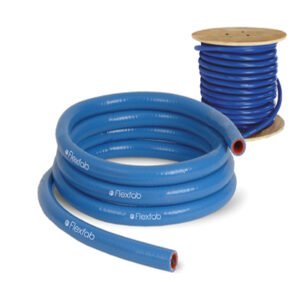Flexible silicone hoses play a crucial role in cooling systems for electronic devices, contributing to effective thermal management.
Here’s how they are used in this context:
- Heat Dissipation: Flexible silicone hoses are employed to transfer coolant or other cooling fluids within electronic cooling systems. They facilitate the movement of these fluids to absorb and carry away heat generated by electronic components such as processors, power modules, and other heat-sensitive devices.
- Connection of Cooling Components: Silicone hoses are used to connect various components within the electronic cooling system, such as heat exchangers, radiators, and cooling plates. These hoses provide a flexible and efficient means of routing coolant to and from these components.
- Integration with Cooling Systems: Flexible silicone hoses are integrated into both air and liquid cooling systems. In liquid cooling setups, hoses transport coolants, such as water or specialized cooling fluids, to absorb and transfer heat away from electronic components.
- Compatibility with Coolants: Silicone hoses are compatible with a variety of coolants used in electronic cooling applications. They are resistant to corrosion and degradation from exposure to water, coolants, and other fluids commonly used for thermal management.
- Vibration Dampening: The flexibility of silicone hoses helps dampen vibrations generated by electronic devices. This is particularly important in environments where minimizing vibrations is crucial for the stability and performance of sensitive electronic components.
- Resistance to High Temperatures: Electronic devices, especially high-performance ones, generate significant heat. Flexible silicone hoses are known for their resistance to high temperatures, ensuring they remain structurally sound and effective in transferring heat even in demanding thermal conditions.
- Customization for System Layouts: Silicone hoses can be customized to fit specific layouts and configurations within electronic cooling systems. This adaptability is valuable in designing cooling solutions that meet the unique requirements of different electronic devices and systems.
- Flexibility in Design: Silicone hoses offer flexibility in the design of cooling systems, allowing for easier integration into compact or intricate spaces within electronic devices. This flexibility aids in achieving efficient thermal performance without compromising the overall design and layout.
- Ease of Installation: The flexibility and lightweight nature of silicone hoses simplify the installation process in electronic cooling systems. This ease of installation contributes to efficient assembly and maintenance of cooling setups in electronic devices.
- Sealing and Leak Prevention: Silicone hoses are designed to provide reliable sealing, minimizing the risk of leaks within the cooling system. This is critical for preventing coolant loss and maintaining the integrity of the cooling process.
In summary, flexible silicone hoses are integral components in electronic cooling systems, ensuring efficient heat dissipation, flexibility in design, and compatibility with a range of coolants. Their properties contribute to the overall effectiveness and reliability of thermal management solutions for electronic devices.
How are flexible silicone hoses utilized in renewable energy systems?
Flexible silicone hoses are utilized in various ways in renewable energy systems, contributing to the efficiency, reliability, and safety of these systems.
Here are several applications in which flexible silicone hoses play a role in renewable energy:
- Solar Thermal Systems: In solar thermal systems, flexible silicone hoses are used to transfer heat-transfer fluids (HTFs) between solar collectors and heat exchangers. These hoses need to withstand high temperatures and resist degradation from exposure to sunlight and heat.
- Solar Water Heating Systems: Flexible silicone hoses are employed in solar water heating systems to transport heated water from solar collectors to storage tanks. The hoses provide flexibility for routing the water through various components of the system.
- Geothermal Heat Pump Systems: Geothermal heat pump systems use flexible silicone hoses to circulate heat-transfer fluids in underground loops or wells. The hoses play a role in transferring heat to or from the ground, contributing to the efficiency of the geothermal heat exchange process.
- Wind Turbine Cooling: Flexible silicone hoses are used in cooling systems for wind turbines, where they transfer coolant to dissipate heat generated by the generator and other components. These hoses withstand temperature variations and harsh environmental conditions.
- Hydroelectric Power Systems: In hydroelectric power systems, silicone hoses can be employed in various cooling and fluid transfer applications. For example, they may be used in cooling systems for generators or to transfer fluids in hydraulic systems.
- Bioenergy Production: In bioenergy systems, where biomass is converted into energy, silicone hoses may be used for transferring liquids or gases in various stages of the production process. They are selected for their resistance to chemicals and compatibility with biofuels.
- Energy Storage Systems: Flexible silicone hoses can be used in thermal energy storage systems, where they transfer heat-transfer fluids to and from storage units. flexible silicone hose These hoses contribute to maintaining the temperature of the storage medium efficiently.
- Photovoltaic (PV) Systems: While silicones are often used in encapsulating and sealing photovoltaic modules, flexible silicone hoses may also find applications in cooling systems for concentrated solar photovoltaic (CSPV) systems, where they transfer coolant to dissipate heat generated by concentrated sunlight.
- Cooling Systems for Electronics in Renewable Energy Equipment: Electronic components in renewable energy systems, such as inverters and controllers, generate heat. Silicone hoses can be used in cooling systems to transfer coolant and dissipate this heat, ensuring the proper functioning and longevity of electronic equipment.
- Customized Applications: The versatility of silicone allows for the customization of hoses to suit specific requirements in renewable energy systems. Custom shapes, sizes, and configurations can be designed to meet the unique needs of different applications within these systems.
In summary, flexible silicone hoses contribute to the efficient operation of various renewable energy systems by facilitating fluid transfer, heat dissipation, and providing durability in challenging environmental conditions. Their resistance to temperature extremes, flexibility, and compatibility with different fluids make them valuable components in the renewable energy industry.
